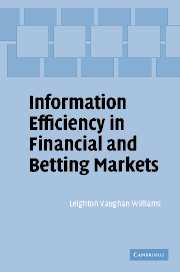Book contents
- Frontmatter
- Contents
- List of figures
- List of tables
- List of contributors
- Introduction
- Part I The concept of information efficiency
- Part II Selected readings
- 4 An assessment of quasi-arbitrage opportunities in two fixed-odds horse-race betting markets
- 5 The presence of favourites and biases in bookmakers' odds
- 6 Searching for semi-strong form inefficiency in the UK racetrack betting market
- 7 Models, markets, polls and pundits: a case study of information efficiency
- 8 Longshot bias: insights from the betting market on men's professional tennis
- 9 Biases and insider trading in exotic bets on thoroughbreds
- 10 On the improbability of information efficient parimutuel betting markets in the presence of heterogeneous beliefs
- 11 Modelling gambling demand in a laboratory casino: discovering the importance of individual-specific effects
- 12 Market efficiency of the 50–30–20–10 horse-racing spread betting market
- 13 Insider trading and bias in a market for state-contingent claims
- 14 Rationality and efficiency in lotto games
- 15 Efficiency of the odds on English professional football matches
- 16 Modelling distance preference in flat racing via average velocity
- 17 Testing for market efficiency in gambling markets: some observations and new statistical tests based on a bootstrap method
- 18 Information (in)efficiency in prediction markets
- Index
- References
16 - Modelling distance preference in flat racing via average velocity
Published online by Cambridge University Press: 09 July 2009
- Frontmatter
- Contents
- List of figures
- List of tables
- List of contributors
- Introduction
- Part I The concept of information efficiency
- Part II Selected readings
- 4 An assessment of quasi-arbitrage opportunities in two fixed-odds horse-race betting markets
- 5 The presence of favourites and biases in bookmakers' odds
- 6 Searching for semi-strong form inefficiency in the UK racetrack betting market
- 7 Models, markets, polls and pundits: a case study of information efficiency
- 8 Longshot bias: insights from the betting market on men's professional tennis
- 9 Biases and insider trading in exotic bets on thoroughbreds
- 10 On the improbability of information efficient parimutuel betting markets in the presence of heterogeneous beliefs
- 11 Modelling gambling demand in a laboratory casino: discovering the importance of individual-specific effects
- 12 Market efficiency of the 50–30–20–10 horse-racing spread betting market
- 13 Insider trading and bias in a market for state-contingent claims
- 14 Rationality and efficiency in lotto games
- 15 Efficiency of the odds on English professional football matches
- 16 Modelling distance preference in flat racing via average velocity
- 17 Testing for market efficiency in gambling markets: some observations and new statistical tests based on a bootstrap method
- 18 Information (in)efficiency in prediction markets
- Index
- References
Summary
Background
While there is a growing academic literature in horse-race betting and other wagering markets (see Vaughan Williams, 2003 and, earlier, Hausch, Lo, and Ziemba, 1994), the overwhelming emphasis in serious academic work (as distinct from commercially orientated ‘get rich quick' offerings) has focused on the study of overall characteristics of markets, such as in favourite-longshot bias issues, rather than in the study of underlying factors which may be used to model racing outcomes themselves. In particular, there appears to have been only one serious published attempt to mathematically model what is arguably one of the most important factors affecting horses’ chances of winning, the manner in which different horses are individually affected by changes in distance, which was by Benter, Miel and Turnbough (1996). In their paper, distance preference, or degree of advantage or disadvantage which should be given a particular horse relative to others when handicapping at a particular distance, is first introduced in relation to models for human running, such as the Hill–Keller model (Keller, 1973; see Benter et al. 1996) and in acknowledgement of work in the physiology of energy expenditure such as Noble (1986), ultimately reducing in principle to a distance preference index for a particular horse, modelled by a quadratic function of distance. Benter et al.'s index was not identified with any particular observable characteristic, such as runtime or average velocity, but rather by a certain notion in relation to competitiveness, where the conjecture from previous work was that each horse has an optimum distance, away from which its competitiveness decreases monotonically. Benter, Miel and Turnbough (1996) then go on to present statistical methods for estimating such functions for various horses, with an emphasis on estimation stability as enhanced by fictitious data, or ‘tack’ points.
Information
- Type
- Chapter
- Information
- Information Efficiency in Financial and Betting Markets , pp. 339 - 345Publisher: Cambridge University PressPrint publication year: 2005
